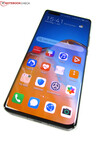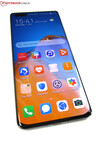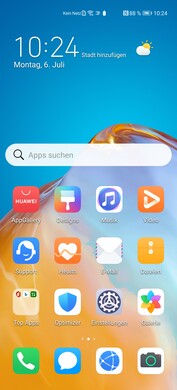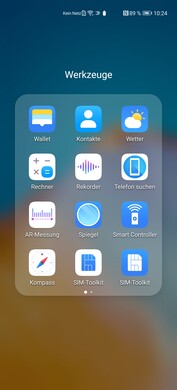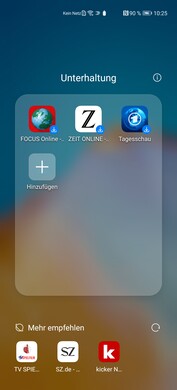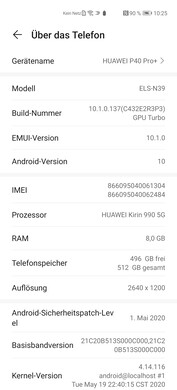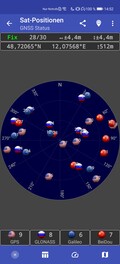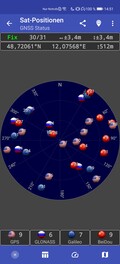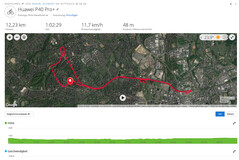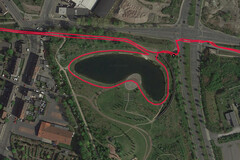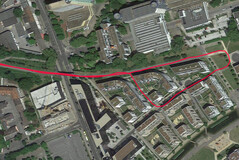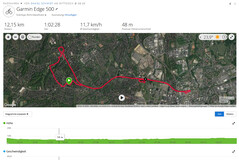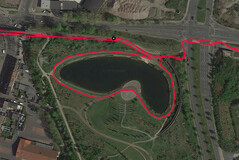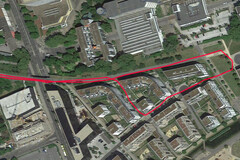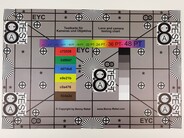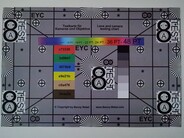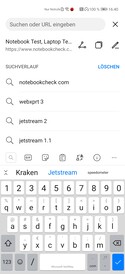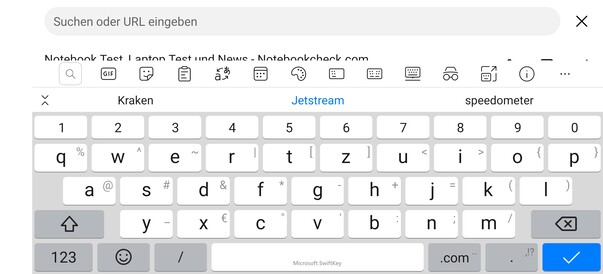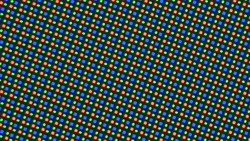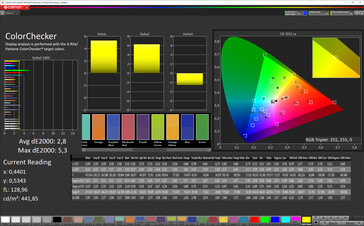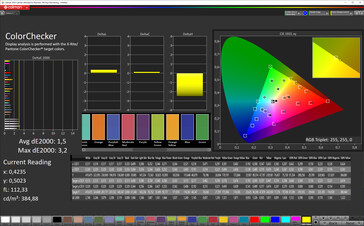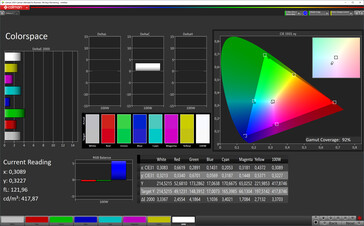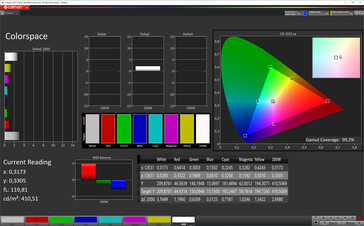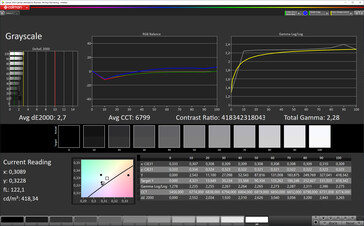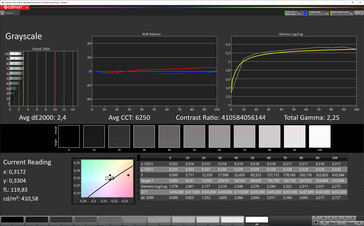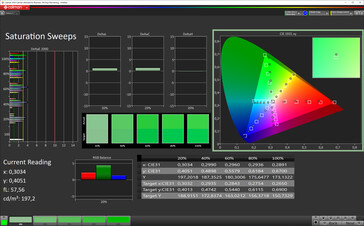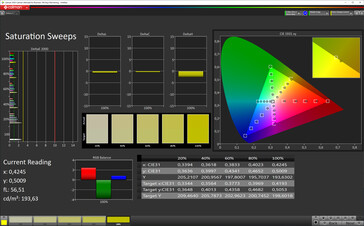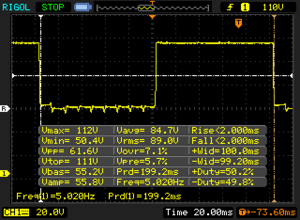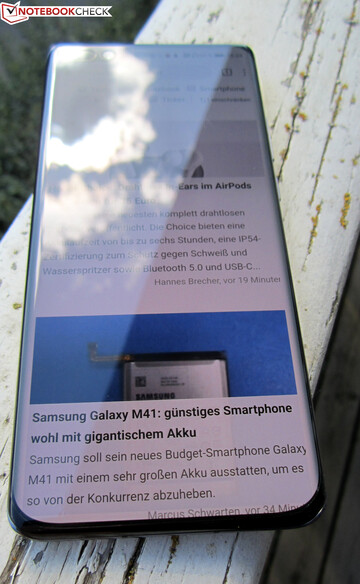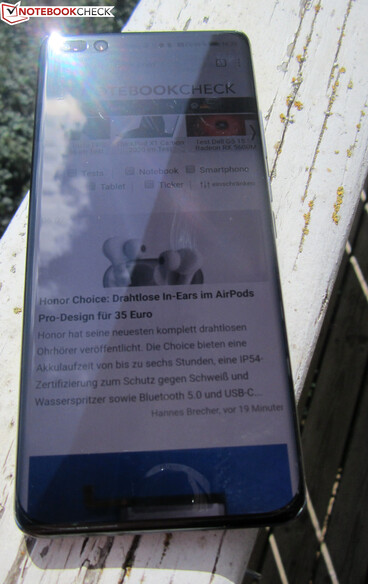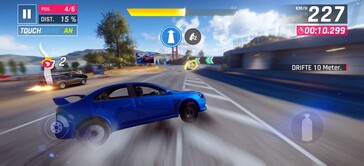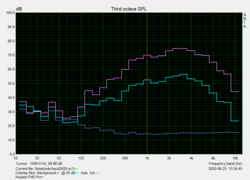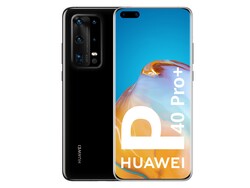Huawei P40 Pro Plus Smartphone Review: Flagship with 100x Zoom
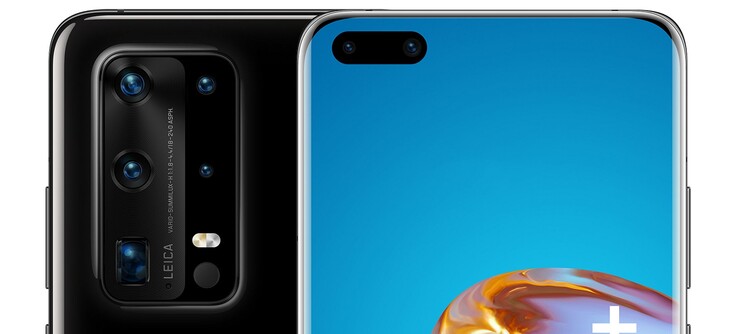
Following the excellent P40 Pro, Huawei has released the P40 Pro Plus, which is the flagship model of the P40 series. Compared to its smaller sibling, the P40 Pro Plus offers slightly better hardware.
There are many similarities to the P40 Pro. For example, they share the 6.58-inch size, 2640x1200 pixel OLED display, high-end Kirin 990 5G SoC, and 8 GB of RAM. Visually, the two devices look almost identical.
The improved camera module is the most important difference. The P40 Pro Plus uses an additional telephoto lens, which allows for an up to 100x digital zoom similar to the Samsung Galaxy S20 Ultra. However, Huawei charges a hefty fee for the intriguing feature. At 1399 Euros (~$1599), the P40 Pro Plus is 400 Euros (~$458) more expensive than the P40 Pro (999 Euros/~$1142).
Competing Devices
Rating | Date | Model | Weight | Drive | Size | Resolution | Price |
|---|---|---|---|---|---|---|---|
| 89.3 % v7 (old) | 07 / 2020 | Huawei P40 Pro Plus Kirin 990 5G, Mali-G76 MP16 | 226 g | 512 GB UFS 3.0 Flash | 6.58" | 2640x1200 | |
| 87.1 % v7 (old) | 09 / 2019 | Apple iPhone 11 Pro Max A13 Bionic, A13 Bionic GPU | 226 g | 64 GB SSD | 6.50" | 2688x1242 | |
| 86.1 % v7 (old) | 03 / 2020 | Oppo Find X2 Pro SD 865, Adreno 650 | 202 g | 512 GB UFS 3.0 Flash | 6.70" | 3168x1440 | |
| 89.4 % v7 (old) | 04 / 2020 | Huawei P40 Pro Kirin 990 5G, Mali-G76 MP16 | 209 g | 256 GB UFS 3.0 Flash | 6.58" | 2640x1200 | |
| 88.5 % v7 (old) | 04 / 2020 | OnePlus 8 Pro SD 865, Adreno 650 | 199 g | 256 GB UFS 3.0 Flash | 6.78" | 3168x1440 | |
| 88.9 % v7 (old) | 03 / 2020 | Samsung Galaxy S20 Ultra Exynos 990, Mali-G77 MP11 | 219 g | 128 GB UFS 3.0 Flash | 6.90" | 3200x1440 |
Case - Ceramic Back and IP68 Protection
Rounded-off display corners, excellent build quality and IP68 protection: The case of the P40 Pro Plus is almost identical to that of the P40 Pro. The differences only become apparent after taking a look at the back.
The two color options "White Ceramic" and "Black Ceramic" hint at it: The back cover of the P40 Pro Plus consists of ceramic, while the P40 Pro's back "only" consists of glass. Second notable difference: Although the main camera on the P40 Pro Plus is located in the same spot as on the P40 Pro, the camera setup itself has changed. While the P40 Pro uses a quad-camera system, the P40 Pro Plus uses five lenses with 100x zoom as a stand-out feature.
With a thickness of 9 mm, the P40 Pro Plus is ever so slightly thicker than the P40 Pro (8 mm), and at 226 g vs. 209 g it is slightly heavier as well. The dimensions are otherwise identical.
Features - Huawei P40 Pro Plus with 512 GB Internal Storage
With 512 GB, the internal storage capacity of the Huawei P40 Pro Plus is twice as large compared to the P40 Pro. As a result, being limited to Huawei's own brand of memory card, the Nano Memory card (NM), is less of an issue. The memory card can be formatted as exFAT, which allows the P40 Pro Plus to store individual files on it that exceed 4 GB.
The USB-OTG-compatible USB Type-C port of the P40 Pro supports video output via a DisplayPort or HDMI adapter. The EMUI desktop mode is also available. Although the USB port runs at USB 3.1 Gen. 1 speeds, the included cable only supports USB 2.0. Furthermore, an infrared transmitter has been integrated into the thin top edge, allowing users to remote control electronic devices, for example.
Software - AppGallery Instead of Google Play
Android 10 with version 10.1 of Huawei's user interface EMUI runs on the P40 Pro Plus. At the time of writing (early July), the latest Android security patches date back to May 1, 2020, making them fairly recent.
Since Huawei has been hit with US sanctions, the manufacturer currently has to ship its smartphones without the Google Play Store. Similarly, other Google services such as YouTube, Gmail, and Maps are off the table.
With the AppGallery, Huawei has developed its own app ecosystem to replace the Google Play Store. Although the number of apps has grown substantially over the past couple of months, there are still not nearly as many apps available as on the Google app store. As an alternative, users can download apps via third-party app stores such as the Amazon Appstore. In order to assist users, the smartphone comes with a search feature called Petal Search, which finds apps across various app stores.
Communication and GPS - P40 Pro Plus with 5G and Gigabit Wi-Fi
The Kirin 990 5G SoC of the P40 Pro Plus uses an integrated 5G modem. While it only supports sub-6 GHz frequencies, it still achieves very fast maximum data transfer rates of 2.3 Gb/s and 1.25 Gb/s for downloads and uploads, respectively.
For Wi-Fi connections, the Huawei smartphone also comes with Wi-Fi 6 and 2x2 MIMO antennas. In conjunction with our reference router Netgear Nighthawk AX12, it achieved excellent upload speeds of 1.6 Gb/s. At 1.4 Gb/s, the download speeds are still above average as well. In either case, the transfer rates remain fairly consistent.
When it comes to the locating capabilities of the P40 Pro Plus, the smartphone relies on the satellite systems GPS, GLONASS, BeiDou and Galileo. While the smartphone takes its time indoors, it then displays our position with an accuracy of within 4.5 meters. Outdoors, the satellite uplink is established very quickly with an accuracy of within around 3.5 meters.
On our 12-km bike ride, the smartphone has to prove its navigation prowess in a real-world scenario. Here, the P40 Pro Plus is able to go head-to-head with the professional navi Garmin Edge 500, which we used to simultaneously record the route. Although our P40 Pro Plus occasionally deviates from the track, the inaccuracies are so small that it is still well suited to navigation tasks.
Telephony and Call Quality - Dual SIM, VoLTE and VoWiFi
The P40 Pro Plus' card slot accepts two nano-SIM cards, either of which can be used as the primary SIM card. It can then be used to connect to 5G networks, while the secondary SIM card is limited to 4G networks. Although the smartphone also supports VoLTE and VoWiFi, the lack of an eSIM strikes us as odd.
Overall, the call quality of the P40 Pro Plus is excellent and voices can be clearly understood even in hands-free mode. The noise-cancelling feature is reliable even in loud environments.
Cameras - Five Lenses and 100x Digital Zoom
The differences between the P40 Pro Plus and the P40 Pro are mostly minor. However, the P40 Pro Plus comes with zoom features that are unmatched by almost any other smartphone.
The 50-MP main optics (wide-angle, f/1.9, OIS), the 40-MP ultra-wide-angle lens (f/1.8), and the 3D depth information sensor are identical between the P40 Pro Plus and the P40 Pro. Meanwhile, the 12-MP telephoto lens on the P40 Pro has been replaced with two telephoto lenses on the P40 Pro Plus: An 8-MP zoom camera (10x optical, f/4.4, OIS) and an 8-MP telephoto lens (3x optical zoom, f/2.4, OIS). In total, the main camera consists of five individual lenses.
Like on the P40 Pro, there is a 32-MP selfie camera with an f/2.2 aperture and a depth sensor on the front.
Like the P40 Pro, the P40 Pro Plus produces stunning photos and video recordings that remain excellent even in low-light situations. However, the zoom capabilities of the P40 Pro Plus are the main advantage compared to the P40 Pro.
Thanks to 10x optical zoom, the P40 Pro Plus still produces great pictures at the respective ranges, while the optical image stabilizer ensures that objects remain in focus. A higher degree of magnification is possible thanks to 20x hybrid and up to 100x digital zoom. However, good results at the maximum zoom level require a flat surface or a tripod. The resulting pictures still look quite decent, provided either one is available.
The transition between zoom steps is smooth - the zoom slider can be moved continuously from the wide-angle setting all the way to 100x enhancement. At higher zoom levels, the camera app displays an additional window. It shows the entire scene as well as the part of the picture that is being magnified.
Image comparison
Choose a scene and navigate within the first image. One click changes the position on touchscreens. One click on the zoomed-in image opens the original in a new window. The first image shows the scaled photograph of the test device.
Daylight scene 1Daylight scene 25x zoomUltra-wide-angleLow-light environmentControlled lighting conditions show that the P40 Pro Plus displays colors even more naturally in the dark than in daylight. The smartphone displays our test chart with consistent sharpness and does not struggle with color gradients or transitions.
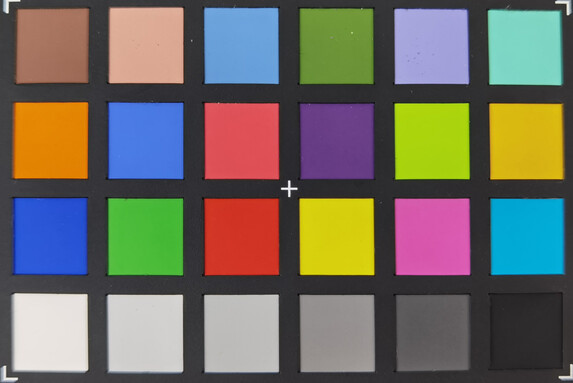
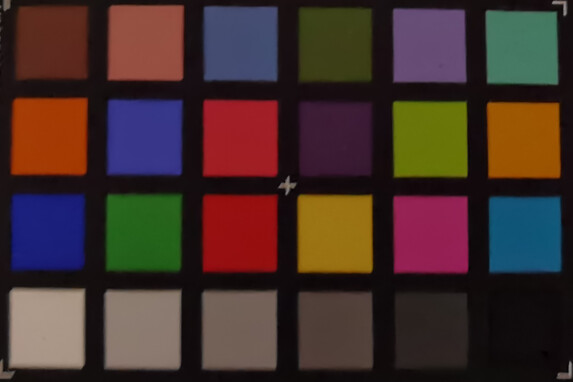
Accessories and Warranty - 40-Watt Quick Charger Included
Huawei includes a modular 40-watt quick charger, a USB 2.0 cable (Type-A to Type-C), a USB-C headset, a SIM tool, a quick-start guide, and a warranty card with the P40 Pro Plus. On its online shop, the manufacturer has various accessories on offer ranging from speakers to wireless charging and protective cases.
The Huawei P40 Pro Plus comes with a 24-month warranty.
Input Devices & Handling - IR Facial Recognition & Gesture Control
Reliable, effortless, quick: That is the P40 Pro Plus user experience in a nutshell. The capacitive touchscreen registers commands instantaneously and the physical buttons offer a great feedback. The haptic feedback of the display can be amplified by enabling touch vibration for typing and swiping.
While the smartphone also supports non-touch gestures, they need to be activated via the settings menu first. The selfie camera is also responsible for unlocking the phone via IR facial recognition, which is not fully 3D-based. It works well regardless, and we have no complaints about the in-display fingerprint sensor, either.
Display - P40 Pro Plus with Color-accurate OLED Panel
The 6.58-inch OLED display of the P40 Pro Plus has a refresh rate of 90 Hz and a native resolution of 2640x1200 pixels (FHD+). The panel of our test device has an average brightness of 672.2 cd/m², which makes it slightly brighter than the P40 Pro, which sits at 575.7 cd/m².
Without the ambient light sensor, the P40 Pro Plus only reaches 417 cd/m². Notably, the luminance increases to 883 cd/m² in the test with an even distribution of bright and dark areas (APL50).
Many OLED panels use pulse-width modulation to control the brightness and the P40 Pro Plus is no exception. Its frequency ranges from 121.4 Hz to 367.6 Hz, which may bother sensitive users. In this case, the display menu item "flicker reduction" can alleviate the issue.
| |||||||||||||||||||||||||
Brightness Distribution: 95 %
Center on Battery: 672 cd/m²
Contrast: ∞:1 (Black: 0 cd/m²)
ΔE ColorChecker Calman: 1.5 | ∀{0.5-29.43 Ø4.81}
ΔE Greyscale Calman: 2.4 | ∀{0.09-98 Ø5.1}
99.3% sRGB (Calman 2D)
Gamma: 2.25
CCT: 6250 K
| Huawei P40 Pro Plus OLED, 2640x1200, 6.6" | Apple iPhone 11 Pro Max OLED, 2688x1242, 6.5" | Huawei P40 Pro OLED, 2640x1200, 6.6" | OnePlus 8 Pro AMOLED, 3168x1440, 6.8" | Oppo Find X2 Pro AMOLED, 3168x1440, 6.7" | Samsung Galaxy S20 Ultra Dynamic AMOLED 2X, 3200x1440, 6.9" | |
|---|---|---|---|---|---|---|
| Screen | 10% | 9% | 32% | -77% | -37% | |
| Brightness middle (cd/m²) | 672 | 790 18% | 584 -13% | 796 18% | 778 16% | 734 9% |
| Brightness (cd/m²) | 672 | 790 18% | 576 -14% | 779 16% | 775 15% | 748 11% |
| Brightness Distribution (%) | 95 | 97 2% | 95 0% | 94 -1% | 99 4% | 95 0% |
| Black Level * (cd/m²) | ||||||
| Colorchecker dE 2000 * | 1.5 | 1.4 7% | 1.1 27% | 0.68 55% | 4.4 -193% | 3.2 -113% |
| Colorchecker dE 2000 max. * | 3.2 | 3.4 -6% | 2.3 28% | 1.55 52% | 8.7 -172% | 6.8 -113% |
| Greyscale dE 2000 * | 2.4 | 1.9 21% | 1.8 25% | 1.1 54% | 5.6 -133% | 2.7 -13% |
| Gamma | 2.25 98% | 2.23 99% | 2.16 102% | 2.237 98% | 2.26 97% | 2.11 104% |
| CCT | 6250 104% | 6466 101% | 6355 102% | 6310 103% | 7250 90% | 6299 103% |
* ... smaller is better
Screen Flickering / PWM (Pulse-Width Modulation)
| Screen flickering / PWM detected | 367.6 Hz | ≤ 99 % brightness setting | |
The display backlight flickers at 367.6 Hz (worst case, e.g., utilizing PWM) Flickering detected at a brightness setting of 99 % and below. There should be no flickering or PWM above this brightness setting. The frequency of 367.6 Hz is relatively high, so most users sensitive to PWM should not notice any flickering. However, there are reports that some users are still sensitive to PWM at 500 Hz and above, so be aware. In comparison: 53 % of all tested devices do not use PWM to dim the display. If PWM was detected, an average of 8255 (minimum: 5 - maximum: 343500) Hz was measured. | |||
The OLED panel shines in our analysis with a spectrophotometer and the CalMAN software. Using either the "normal" or the "vivid" mode produces very accurate colors, with the "normal" mode being slightly ahead in terms of the accuracy.
Display Response Times
| ↔ Response Time Black to White | ||
|---|---|---|
| 2.8 ms ... rise ↗ and fall ↘ combined | ↗ 1.6 ms rise | |
| ↘ 1.2 ms fall | ||
| The screen shows very fast response rates in our tests and should be very well suited for fast-paced gaming. In comparison, all tested devices range from 0.1 (minimum) to 240 (maximum) ms. » 12 % of all devices are better. This means that the measured response time is better than the average of all tested devices (20.4 ms). | ||
| ↔ Response Time 50% Grey to 80% Grey | ||
| 4 ms ... rise ↗ and fall ↘ combined | ↗ 2 ms rise | |
| ↘ 2 ms fall | ||
| The screen shows very fast response rates in our tests and should be very well suited for fast-paced gaming. In comparison, all tested devices range from 0.165 (minimum) to 636 (maximum) ms. » 13 % of all devices are better. This means that the measured response time is better than the average of all tested devices (31.9 ms). | ||
Thanks to its great luminance, the outdoor visibility of the P40 Pro Plus is good, provided you are not in direct sunlight. On very bright days, the fact that the brightness could have been slightly higher becomes apparent. Although this is a very minor criticism, it is warranted for a smartphone in this price class, where users can expect very few compromises.
Performance - Kirin 990 5G Delivers
The HiSilicon Kirin 990 5G SoC is at the heart of the P40 Pro Plus and is slightly faster than the 4G version Kirin 990. 8 GB of LPDDR4X RAM and the graphics unit ARM Mali-G76 MP16 accompany the octa-core processor. Since the hardware is identical to the P40 Pro, both models achieve the same scores in synthetic benchmarks.
The performance of the P40 Pro Plus is high enough for it to make the exclusive list of the fastest current Android devices. That being said, Qualcomm and Apple SoC competitors such as the Oppo Find X2 Pro, OnePlus 8 Pro and the Apple iPhone 11 Pro Max tend to be faster by a slim margin, particularly when it comes to graphics-intensive benchmarks.
| PCMark for Android | |
| Work performance score (sort by value) | |
| Huawei P40 Pro Plus | |
| Huawei P40 Pro | |
| OnePlus 8 Pro | |
| Oppo Find X2 Pro | |
| Samsung Galaxy S20 Ultra | |
| Average HiSilicon Kirin 990 5G (10628 - 14814, n=4) | |
| Work 2.0 performance score (sort by value) | |
| Huawei P40 Pro Plus | |
| Huawei P40 Pro | |
| OnePlus 8 Pro | |
| Oppo Find X2 Pro | |
| Samsung Galaxy S20 Ultra | |
| Average HiSilicon Kirin 990 5G (8512 - 11509, n=4) | |
Version 10.1 of the Huawei browser comes preinstalled on the P40 Pro Plus, and it uses Bing as its default search engine. Browsing with it feels snappy and responsive, which our browser benchmarks also confirm. Like all other Android smartphones, however, the P40 Pro Plus does not stand a chance against the Apple iPhone 11 Pro Max, which is in a league of its own.
| Jetstream 2 - 2.0 Total Score | |
| Average of class Smartphone (13.8 - 387, n=153, last 2 years) | |
| Apple iPhone 11 Pro Max (Safari Mobile 13.1) | |
| Huawei P40 Pro (Huawei Browser 10.1) | |
| Huawei P40 Pro Plus (Huawei Browser 10.1.2.322) | |
| Oppo Find X2 Pro (Chrome 80) | |
| OnePlus 8 Pro (Chrome 80) | |
| Average HiSilicon Kirin 990 5G (55.6 - 70, n=4) | |
| Samsung Galaxy S20 Ultra (Chrome 80) | |
| JetStream 1.1 - Total Score | |
| Apple iPhone 11 Pro Max (Safari Mobile 13.1) | |
| Huawei P40 Pro (Huawei Browser 10.1) | |
| Huawei P40 Pro Plus (Huawei Browser 10.1.2.322) | |
| OnePlus 8 Pro (Chrome 80) | |
| Oppo Find X2 Pro (Chrome 80) | |
| Average HiSilicon Kirin 990 5G (103.2 - 116.6, n=4) | |
| Samsung Galaxy S20 Ultra (Chrome 80) | |
| Speedometer 2.0 - Result | |
| Average of class Smartphone (15.2 - 585, n=136, last 2 years) | |
| Apple iPhone 11 Pro Max (Safari Mobile 13.1) | |
| Huawei P40 Pro (Huawei Browser 10.1) | |
| Huawei P40 Pro Plus (Huawei Browser 10.1.2.322) | |
| Oppo Find X2 Pro (Chrome 80) | |
| OnePlus 8 Pro (Chome 80) | |
| Average HiSilicon Kirin 990 5G (63 - 71.8, n=4) | |
| Samsung Galaxy S20 Ultra (Chrome 80) | |
| WebXPRT 3 - Overall | |
| Apple iPhone 11 Pro Max (Safari Mobile 13.1) | |
| Average of class Smartphone (38 - 347, n=53, last 2 years) | |
| Huawei P40 Pro Plus (Huawei Browser 10.1.2.322) | |
| Average HiSilicon Kirin 990 5G (95 - 124, n=3) | |
| OnePlus 8 Pro (Chrome 80) | |
| Oppo Find X2 Pro (Chrome 80) | |
| Samsung Galaxy S20 Ultra (Chrome 80) | |
| Huawei P40 Pro | |
| Octane V2 - Total Score | |
| Apple iPhone 11 Pro Max (Safari Mobile 13.1) | |
| Average of class Smartphone (2228 - 100368, n=203, last 2 years) | |
| Huawei P40 Pro (Huawei Browser 10.1) | |
| OnePlus 8 Pro (Chrome 80) | |
| Huawei P40 Pro Plus (Huawei Browser 10.1.2.322) | |
| Oppo Find X2 Pro (Chrome 80) | |
| Average HiSilicon Kirin 990 5G (20917 - 23690, n=4) | |
| Samsung Galaxy S20 Ultra (Chrome 80) | |
| Mozilla Kraken 1.1 - Total | |
| Samsung Galaxy S20 Ultra (Chrome 80) | |
| Average HiSilicon Kirin 990 5G (1914 - 2287, n=4) | |
| Oppo Find X2 Pro (Chrome 80) | |
| OnePlus 8 Pro (Chrome 80) | |
| Huawei P40 Pro (Huawei Browser 10.1) | |
| Huawei P40 Pro Plus (Huawei Browser 10.1.2.322) | |
| Average of class Smartphone (277 - 28190, n=157, last 2 years) | |
| Apple iPhone 11 Pro Max (Safari Mobile 13.1) | |
* ... smaller is better
The P40 Pro Plus is equipped with 512 GB of UFS 3.0 storage with an excellent read and write performance. Oddly, it significantly outperforms the P40 Pro, which is equipped with the same type of storage, in terms of sequential write and 4 KB random read speeds, and it also claims first place in our comparison when it comes to the overall transfer rates. By contrast, reading from or writing to the memory card with the P40 Pro Plus is not any faster than with competing devices.
| Huawei P40 Pro Plus | Huawei P40 Pro | OnePlus 8 Pro | Oppo Find X2 Pro | Samsung Galaxy S20 Ultra | Average 512 GB UFS 3.0 Flash | Average of class Smartphone | |
|---|---|---|---|---|---|---|---|
| AndroBench 3-5 | -17% | -26% | -26% | -22% | -16% | 30% | |
| Sequential Read 256KB (MB/s) | 1802 | 1775 -1% | 1627 -10% | 1606 -11% | 1632 -9% | 1496 ? -17% | 2218 ? 23% |
| Sequential Write 256KB (MB/s) | 911 | 395.7 -57% | 730 -20% | 729 -20% | 697 -23% | 632 ? -31% | 1817 ? 99% |
| Random Read 4KB (MB/s) | 324.1 | 228.1 -30% | 208.3 -36% | 202.6 -37% | 202.4 -38% | 236 ? -27% | 296 ? -9% |
| Random Write 4KB (MB/s) | 318.9 | 271.8 -15% | 197.7 -38% | 205 -36% | 221.4 -31% | 244 ? -23% | 341 ? 7% |
| Sequential Read 256KB SDCard (MB/s) | 82.3 ? | 82.3 ? 0% | 67.6 ? -18% | 82.5 ? 0% | |||
| Sequential Write 256KB SDCard (MB/s) | 67.4 ? | 68.1 ? 1% | 58.3 ? -14% | 69.8 ? 4% |
Gaming - 90-Hz Display Is Not an Advantage for the P40 Pro Plus
The P40 Pro Plus is more than well equipped for gaming. The combination of the Kirin 990 5G and ARM Mali-G76 MP16 delivers great performance. As our test tool Gamebench shows, it is easily sufficient for smoothly displaying the latest titles at high graphics settings. When holding the smartphone in landscape mode, users will have to be careful not to block the speaker with their hands.
The 90-Hz refresh rate of the OLED screen is not necessarily an advantage, particularly since not every game supports it. In our test, this applied to both Asphalt 9: Legends and PUBG Mobile. These two titles simply refused to cross the 30 FPS threshold.
Emissions - P40 Pro Plus with Weak Audio
Temperature
The thermals of the P40 Pro Plus match our expectations and its surface temperatures barely rise during use. As GFXBench's battery test shows however, a few tricks under the hood of the smartphone were necessary in order to achieve this.
The T-Rex test, during which the same scene is rendered 30 times in succession, is undemanding in terms of graphics load. After the first loop, the performance already drops substantially and remains on a lower level throughout the remainder of the test. Conversely, the frame rate remains consistently high in the more-demanding Manhattan test. The observed throttling behavior does not need to be overrated though, since there is still an abundance of performance available.
(+) The maximum temperature on the upper side is 33.3 °C / 92 F, compared to the average of 35.2 °C / 95 F, ranging from 21.9 to 247 °C for the class Smartphone.
(+) The bottom heats up to a maximum of 31.2 °C / 88 F, compared to the average of 33.9 °C / 93 F
(+) In idle usage, the average temperature for the upper side is 28.2 °C / 83 F, compared to the device average of 32.9 °C / 91 F.
Speaker
While the speaker of the P40 Pro Plus reproduces voices clearly, the sound it produces feels weak overall, which can be partially attributed to its lack of bass. For a high-end smartphone, the audio experience is somewhat lackluster.
The P40 Pro Plus fares better when the included headphones are connected to the USB Type-C port or when pairing an external audio device with the Huawei phone via Bluetooth.
Due to the trade war between China (Huawei) and the US government, users not only lose access to the Google services but also Bluetooth audio codecs such as aptX and aptX HD.
Huawei P40 Pro Plus audio analysis
(+) | speakers can play relatively loud (83 dB)
Bass 100 - 315 Hz
(-) | nearly no bass - on average 23.8% lower than median
(±) | linearity of bass is average (11.2% delta to prev. frequency)
Mids 400 - 2000 Hz
(±) | higher mids - on average 5.2% higher than median
(+) | mids are linear (5.8% delta to prev. frequency)
Highs 2 - 16 kHz
(±) | higher highs - on average 6.2% higher than median
(+) | highs are linear (5% delta to prev. frequency)
Overall 100 - 16.000 Hz
(±) | linearity of overall sound is average (23.2% difference to median)
Compared to same class
» 51% of all tested devices in this class were better, 7% similar, 42% worse
» The best had a delta of 12%, average was 35%, worst was 134%
Compared to all devices tested
» 68% of all tested devices were better, 6% similar, 26% worse
» The best had a delta of 4%, average was 24%, worst was 134%
Huawei P40 Pro audio analysis
(+) | speakers can play relatively loud (89.1 dB)
Bass 100 - 315 Hz
(-) | nearly no bass - on average 27.3% lower than median
(±) | linearity of bass is average (11.8% delta to prev. frequency)
Mids 400 - 2000 Hz
(±) | reduced mids - on average 5.3% lower than median
(+) | mids are linear (4.8% delta to prev. frequency)
Highs 2 - 16 kHz
(+) | balanced highs - only 4.4% away from median
(+) | highs are linear (2.7% delta to prev. frequency)
Overall 100 - 16.000 Hz
(±) | linearity of overall sound is average (18.5% difference to median)
Compared to same class
» 18% of all tested devices in this class were better, 10% similar, 72% worse
» The best had a delta of 12%, average was 35%, worst was 134%
Compared to all devices tested
» 40% of all tested devices were better, 8% similar, 52% worse
» The best had a delta of 4%, average was 24%, worst was 134%
Battery Life - Solid but Not Phenomenal
Energy Consumption
Compared to the majority of its competitors, the P40 Pro Plus consumes far less power both while idling and under load. Only the P40 Pro is even more energy efficient.
The 4200-mAh lithium-polymer battery can be recharged very quickly with the included 40-watt charger. According to our measurements, fully recharging the empty device only took 75 minutes. After 25 minutes, the battery is already at 50%. The smartphone can also be charged wirelessly at up to 40 watts, whereas the P40 Pro only supports wireless charging at up to 27 watts.
| Off / Standby | |
| Idle | |
| Load |
|
Key:
min: | |
| Huawei P40 Pro Plus 4200 mAh | Apple iPhone 11 Pro Max 3969 mAh | Huawei P40 Pro 4200 mAh | OnePlus 8 Pro 4510 mAh | Oppo Find X2 Pro 4260 mAh | Samsung Galaxy S20 Ultra 5000 mAh | Average HiSilicon Kirin 990 5G | Average of class Smartphone | |
|---|---|---|---|---|---|---|---|---|
| Power Consumption | -22% | 8% | -86% | -77% | -18% | -22% | -31% | |
| Idle Minimum * (Watt) | 0.82 | 0.92 -12% | 0.92 -12% | 2.2 -168% | 1.47 -79% | 0.76 7% | 1.24 ? -51% | 0.857 ? -5% |
| Idle Average * (Watt) | 2.06 | 2.9 -41% | 1.41 32% | 3.3 -60% | 3.43 -67% | 1.91 7% | 2.33 ? -13% | 1.418 ? 31% |
| Idle Maximum * (Watt) | 2.07 | 2.94 -42% | 1.47 29% | 3.7 -79% | 3.52 -70% | 1.96 5% | 2.49 ? -20% | 1.583 ? 24% |
| Load Average * (Watt) | 2.99 | 3.65 -22% | 3.35 -12% | 5.9 -97% | 6.2 -107% | 4.72 -58% | 3.55 ? -19% | 7.16 ? -139% |
| Load Maximum * (Watt) | 6.64 | 6.18 7% | 6.37 4% | 8.3 -25% | 10.63 -60% | 10.15 -53% | 7.09 ? -7% | 10.9 ? -64% |
* ... smaller is better
Battery Life
With 18.5 hours of H.264 video playback and 12.5 hours of simulated web browsing, the P40 Pro Plus achieves good runtimes that are almost identical to those of the P40 Pro. However, the OnePlus 8 Pro and particularly the Apple iPhone 11 Pro Max manage to squeeze even longer runtimes out of their batteries.
| Huawei P40 Pro Plus 4200 mAh | Apple iPhone 11 Pro Max 3969 mAh | Huawei P40 Pro 4200 mAh | OnePlus 8 Pro 4510 mAh | Oppo Find X2 Pro 4260 mAh | Samsung Galaxy S20 Ultra 5000 mAh | |
|---|---|---|---|---|---|---|
| Battery Runtime | 55% | -0% | 26% | -13% | 9% | |
| Reader / Idle (h) | 23.7 | 43.6 84% | 24.6 4% | 35.1 48% | 31 31% | |
| H.264 (h) | 18.6 | 22.4 20% | 19 2% | 17.1 -8% | 18.9 2% | |
| WiFi v1.3 (h) | 12.5 | 15.2 22% | 12.4 -1% | 15.4 23% | 10.9 -13% | 12 -4% |
| Load (h) | 3.5 | 6.8 94% | 3.3 -6% | 4.9 40% | 3.7 6% |
Pros
Cons
Verdict - Amazing Smartphone with Considerable Disadvantages
One great smartphone after the other: Like its sibling, the P40 Pro, the Huawei P40 Pro Plus is an excellent smartphone. However, the differences between them are so small that spending 1399 Euros (~$1599) on the P40 flagship may not be the best choice, particularly in light of the fact that the P40 Pro does the same job about as well for just 999 Euros (~$1142).
While the Huawei P40 Pro Plus is a great smartphone, it faces three challenges: There are no Google services, it is very expensive, and it is almost identical to the P40 Pro.
100x digital zoom and 10x optical zoom are clear advantages of the P40 Pro Plus. That being said, only a very few users will feel limited by the 50x digital zoom of the P40 Pro. The remaining differences in terms of the features certainly do not make up for the higher price: Twice as much storage space, faster wireless charging and a ceramic back instead of a glass back.
The P40 Pro Plus did not have much choice when it comes to the lack of Google services. Still, this drawback disqualifies the smartphone for users who rely on them. The Samsung Galaxy S20 Ultra is the first alternative that comes to mind: The base model is significantly cheaper than the P40 Pro Plus and it comes with Google services, 5G and the same 100x zoom option.
Huawei P40 Pro Plus
- 08/31/2022 v7 (old)
Manuel Masiero







